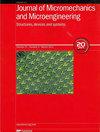用于为微电子电路提供可持续动力的微流体碳布基酶法葡萄糖生物燃料电池 *
IF 2.1
4区 工程技术
Q2 ENGINEERING, ELECTRICAL & ELECTRONIC
引用次数: 0
摘要
由于微流体超低功耗能量收集技术的发展,酶促微流体生物燃料电池(EBFCs)装置的改进引起了广泛关注。碳布(CC)是一种有效的可再生能源,由于其固有的品质和优异的性能,被用作各种微小设备的传统电源的理想纸质替代品。所开发的微流体 EBFC 利用葡萄糖作为燃料,碳布作为生物电极,葡萄糖氧化酶作为阳极,漆酶作为阴极。经测量,CC-EBFC 的最大稳定开路电压为 475 mV,300 mV 时的峰值功率密度为 85 µW cm-2,电流密度为 484 µA cm-2。牛血清白蛋白和增压电路改善了该装置的功率性能,增压电路也涂有涂层并连接到负载上以稳定性能。这项工作的新颖之处在于,使用带有微流体通道的柔性碳布基底在生物燃料电池中具有额外的优势。LTC3108EDE DC-DC 升压器被用来增加能量,并达到 5 V 的高充电电压,使数字手表的工作电压达到 3 V。本文章由计算机程序翻译,如有差异,请以英文原文为准。
Microfluidic carbon cloth-based enzymatic glucose biofuel cell for sustainably powering a microelectronic circuit *
Enhancing enzymatic microfluidic biofuel cells (EBFCs) devices has garnered significant attention due to the development of microfluidic ultra-low power energy-gathering techniques. To facilitate the ability to create microfluidic EBFCs, a carbon cloth (CC) has been considered since they are effective renewable energy sources and utilized as the ideal paper-based substitute for traditional power supplies for a variety of tiny devices due to their inherent qualities and exceptional performance. The developed microfluidic EBFC utilized glucose as a fuel, carbon cloth as the bioelectrode, Glucose oxidase for the anode, and laccase for the cathode. The maximum stable open circuit voltage of CC-EBFC was measured to be 475 mV with a peak power density of 85 µW cm−2 at 300 mV and a current density of 484 µA cm−2. The power performance of the device was improved by bovine serum albumin and a booster circuit, which was also coated and connected to the load to stabilize the performance. The novelty of the work is that using a flexible substrate of carbon cloth, with a microfluidic channel, has an added advantage in the biofuel cell. LTC3108EDE DC–DC booster was used to increase energy and attain a high charging voltage of 5 V to operate a digital watch up to 3 V. With minimal weight and flexibility; this minuscule device opens up new possibilities to sustainably power wearable and portable microelectronic devices.
求助全文
通过发布文献求助,成功后即可免费获取论文全文。
去求助
来源期刊

Journal of Micromechanics and Microengineering
工程技术-材料科学:综合
CiteScore
4.50
自引率
4.30%
发文量
136
审稿时长
2.8 months
期刊介绍:
Journal of Micromechanics and Microengineering (JMM) primarily covers experimental work, however relevant modelling papers are considered where supported by experimental data.
The journal is focussed on all aspects of:
-nano- and micro- mechanical systems
-nano- and micro- electomechanical systems
-nano- and micro- electrical and mechatronic systems
-nano- and micro- engineering
-nano- and micro- scale science
Please note that we do not publish materials papers with no obvious application or link to nano- or micro-engineering.
Below are some examples of the topics that are included within the scope of the journal:
-MEMS and NEMS:
Including sensors, optical MEMS/NEMS, RF MEMS/NEMS, etc.
-Fabrication techniques and manufacturing:
Including micromachining, etching, lithography, deposition, patterning, self-assembly, 3d printing, inkjet printing.
-Packaging and Integration technologies.
-Materials, testing, and reliability.
-Micro- and nano-fluidics:
Including optofluidics, acoustofluidics, droplets, microreactors, organ-on-a-chip.
-Lab-on-a-chip and micro- and nano-total analysis systems.
-Biomedical systems and devices:
Including bio MEMS, biosensors, assays, organ-on-a-chip, drug delivery, cells, biointerfaces.
-Energy and power:
Including power MEMS/NEMS, energy harvesters, actuators, microbatteries.
-Electronics:
Including flexible electronics, wearable electronics, interface electronics.
-Optical systems.
-Robotics.
 求助内容:
求助内容: 应助结果提醒方式:
应助结果提醒方式:


